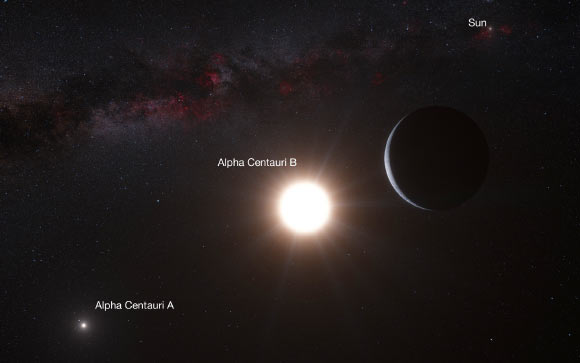Theoretical physicist Prof. Stephen Hawking and science philanthropist Yuri Milner unveiled this week a new initiative, called Breakthrough Starshot, to send light-propelled nanocrafts toward Alpha Centauri.

This artist’s impression shows Alpha Centauri Bb orbiting the star Alpha Centauri B, a member of the triple star system that is the closest to Earth. Alpha Centauri B is the most brilliant object in the sky and the other dazzling object is Alpha Centauri A. Our own Sun is visible to the upper right. Image credit: ESO / L. Calçada / Nick Risinger, skysurvey.org.
Breakthrough Starshot is a $100 million research and engineering program aiming to demonstrate proof of concept for light-propelled nanocrafts.
These could fly at 20 percent of light speed and capture images of possible planets and other scientific data in the Alpha Centauri system just over 20 years after their launch.
The program will be led by Pete Worden, the former director of NASA’s AMES Research Center, and advised by a committee of world-class scientists and engineers. The board will consist of Prof. Hawking, Milner, and Mark Zuckerberg, Founder and CEO, Facebook.
“Earth is a wonderful place, but it might not last forever,” Prof. Hawking said.
“Sooner or later, we must look to the stars. Breakthrough Starshot is a very exciting first step on that journey.”
“The human story is one of great leaps. 55 years ago today (April 12), Yuri Gagarin became the first human in space. Today, we are preparing for the next great leap – to the stars,” said Milner, founder of the Breakthrough Initiatives and DST Global.
Worden added: “we take inspiration from Vostok, Voyager, Apollo and the other great missions.”
“It’s time to open the era of interstellar flight, but we need to keep our feet on the ground to achieve this.”
Breakthrough Starshot’s research and engineering phase is expected to last several years.
Following that, development of the ultimate mission to Alpha Centauri would require a budget comparable to the largest current scientific experiments, and would involve:
(i) building a ground-based kilometer-scale light beamer at high altitude in dry conditions;
(ii) generating and storing a few gigawatt hours of energy per launch;
(iii) launching a ‘mothership’ carrying thousands of nanocrafts to a high-altitude orbit;
(iv) taking advantage of adaptive optics technology in real time to compensate for atmospheric effects;
(v) focusing the light beam on the lightsail to accelerate individual nanocrafts to the target speed within minutes;
(vi) accounting for interstellar dust collisions en route to the target;
(vii) capturing images of planet(s) in the Alpha Centauri system, and other scientific data, and transmitting them back to Earth using a compact on-board laser communications system;
(viii) using the same light beamer that launched the nanocrafts to receive data from them over four years later.
According to astronomers, Alpha Centauri is the nearest stellar system to our Solar System — only 4.37 light-years away.
With today’s fastest spacecraft, it would take about 30,000 years to get there.
Alpha Centauri is actually a triple star – a system consisting of two Sun-like stars orbiting close to each other, known as Alpha Centauri A and B, and a more distant component, Proxima Centauri (also known as Alpha Centauri C).
Alpha Centauri A is a yellow star with a spectral type of G2, exactly the same as the Sun’s. Alpha Centauri B is an orange star with a spectral type of K1. Proxima is a faint red dwarf with a spectral type of M5.
Alpha Centauri A and B orbit each other in 80 years with a mean separation of 23 AU (astronomical units). The separation of Proxima Centauri from Alpha Centauri A and B is about 0.2 light years.
Scientists believe at least two planets exist in this stellar system. Both orbit the same component, Alpha Centauri B.
One of the planets, Alpha Centauri Bb, was discovered in 2012 by a team of astronomers led by Xavier Dumusque from Geneva Observatory and the Centro de Astrofisica da Universidade do Porto.
It has a mass of 1.13 Earth masses and orbits its host star every 3.24 days at a distance of about 3.7 million miles (6 million km), much closer than Mercury is to the Sun in the Solar System.
The second planet, Alpha Centauri Bc, was discovered in 2015 by Cavendish Laboratory astronomer Brice-Olivier Demory and co-authors.
It has an orbital period of 20.4 days and a radius 0.92 times that of the Earth.







